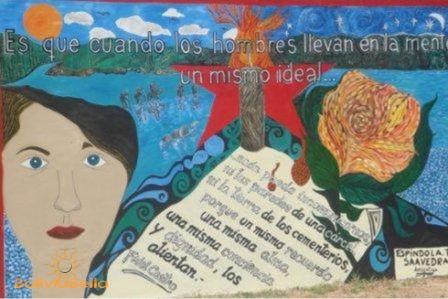|
Vallegrande in Santa Cruz Bolivia Vallegrande, located about 80 miles Southwest of the city of
Santa Cruz,
was founded in 1612 by the Spanish and by the late 1800’s had a population of over 20,000. Today it has only about 5500 residents and is primarily agricultural. There are three reasons a town so small has become so well-known.
First and foremost, it is here that the body of Ernesto (“Che”) Guevara was found in 1997. He had been captured by Bolivian General Gary Prado Salmón and executed in a nearby town called La Higuera by CIA-backed Bolivian soldiers in 1967, a time when the Argentine doctor-turned-Cuban-citizen-turned-socialist guerrilla warrior was considered a great threat to democracy because of his close ties with Fidel Castro, his role in the Cuban revolution, and his socialist work in Africa. (Castro eventually fired Che Guevara in a very humiliating public letter and Guevara renounced his Cuban citizenship, which is how Bolivia eventually became his last hiding place and refuge.) His body was put on display for the international media atop a double sink in the town’s tiny medical center. It then disappeared; however, to the great chagrin of those who thought they had silenced him, El Che became a martyr and his image has been the international symbol for socialism ever since. When in 1997 his body was found beneath the town’s small airstrip, socialists around the world rejoiced. Soon after his remains were returned to his family in Cuba (his children live there), work began to transform the town into a sort of a sanctuary. Bolivia quickly capitalized on the discovery, banking on his ever-increasing popularity to make it an important tourist attraction (although Bolivia's socialists claim they radically HATE capitalists). Today tourists can traverse the Ruta del Che (Che Guevara Trail) making stops along the way at towns like Samaipata, Camiri, Charagua, other towns in the Chaco region, and of course La Higuera (where he was killed) and Vallegrande; at the Che Guevara Museum which contains photographs and historical memorabilia; and the site of his grave (a mass grave in which othes of his group of guerrillas were also interred) which is now a full-fledged mausoleum with flower-adorned grave markers. Each year thousands of people travel to Vallegrande to celebrate the anniversary of his death. He is more popular now than 40 years ago when the Che himself believed he had failed in his attempt to spread the gospel of socialism throughout the continent. Celebrations are held yearly with music and dancing, lectures and speeches, art exhibits, and sidewalk sales where you can purchase t-shirts, handbags, caps and other souvenirs with his image on them. Che Guevara is big business in Bolivia. Vallegrande’s second claim to fame is a series of caves and other sites on which rock paintings of animals and human features have been found. Some are believed to be thousands of years old while others, such as several paintings that appear to be masks, are believed to be just one thousand years old. Another figure of a person holding a cross is thought to be from the colonial period just a few hundred years ago. Rock art has been found in hundreds of places in Bolivia, so much so that in 1987 a research society was founded to study the various sites called the Sociedad de Investigación del Arte Rupestre de Bolivia (Bolivian Rock Art Research Society). Most of these sites are in the western mountainous region. Very few sites, including the ones here and some in the
Chiquitos
region, are located in the eastern tropics of Bolivia, which is why Vallegrande is a unique site for
rock paintings.
Vallegrande (which literally means "big valley") has a town slogan: "Dios te hizo valle, pero tu gente te hizo grande." (God made you a valley but your people made you big). For this and other tours in Bolivia, contact Ruta Verde Bolivia.     |
